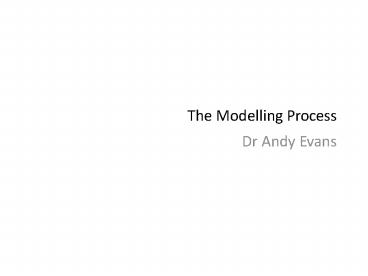The Modelling Process - PowerPoint PPT Presentation
Title: The Modelling Process
1
The Modelling Process
- Dr Andy Evans
2
This lecture
- The modelling process
- Identify interesting patterns
- Build a model of elements you think interact and
the processes / decide on variables - Verify model
- Optimise/Calibrate the model
- Validate the model/Visualisation
- Sensitivity testing
- Model exploration and prediction
- Prediction validation
3
- Preparing to model
- Verification
- Calibration/Optimisation
- Validation
- Sensitivity testing and dealing with error
4
Preparing to model
- What questions do we want answering?
- Do we need something more open-ended?
- Literature review
- what do we know about fully?
- what do we know about in sufficient detail?
- what don't we know about (and does this
matter?). - What can be simplified, for example, by replacing
them with a single number or an AI? - Housing model detail of mortgage rates
variation with economy, vs. a time-series of
data, vs. a single rate figure. - It depends on what you want from the model.
5
Data review
- Outline the key elements of the system, and
compare this with the data you need. - What data do you need, what can you do without,
and what can't you do without?
6
Data review
- Model initialisation
- Data to get the model replicating reality as it
runs. - Model calibration
- Data to adjust variables to replicate reality.
- Model validation
- Data to check the model matches reality.
- Model prediction
- More initialisation data.
7
Model design
- If the model is possible given the data, draw it
out in detail. - Where do you need detail.
- Where might you need detail later?
- Think particularly about the use of interfaces to
ensure elements of the model are as loosely tied
as possible. - Start general and work to the specifics. If you
get the generalities flexible and right, the
model will have a solid foundation for later.
8
Model design
- Agent
- Step
Person GoHome GoElsewhere
Thug Fight
Vehicle Refuel
9
- Preparing to model
- Verification
- Calibration/Optimisation
- Validation
- Sensitivity testing and dealing with error
10
Verification
- Does your model represent the real system in a
rigorous manner without logical inconsistencies
that aren't dealt with? - For simpler models attempts have been made to
automate some of this, but social and
environmental models are waaaay too complicated. - Verification is therefore largely by checking
rulesets with experts, testing with abstract
environments, and through validation.
11
Verification
- Test on abstract environments.
- Adjust variables to test model elements one at a
time and in small subsets. - Do the patterns look reasonable?
- Does causality between variables seem reasonable?
12
Model runs
- Is the system stable over time (if expected)?
- Do you think the model will run to an equilibrium
or fluctuate? - Is that equilibrium realistic or not?






























